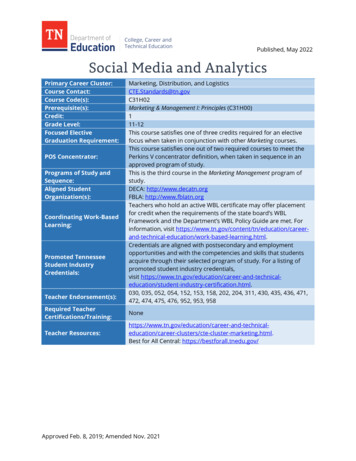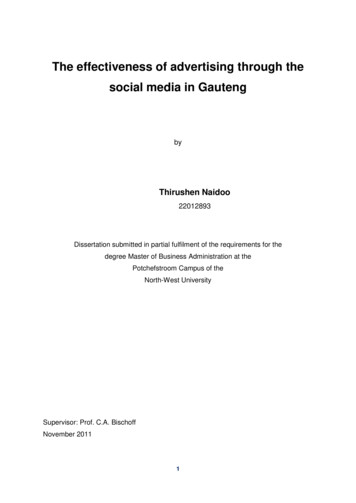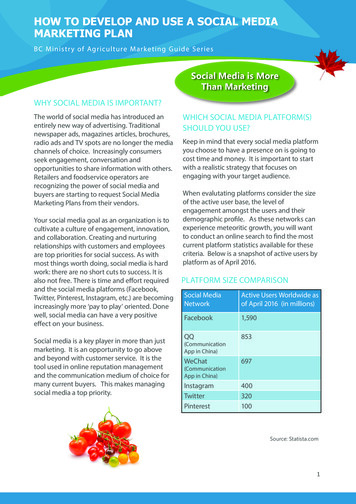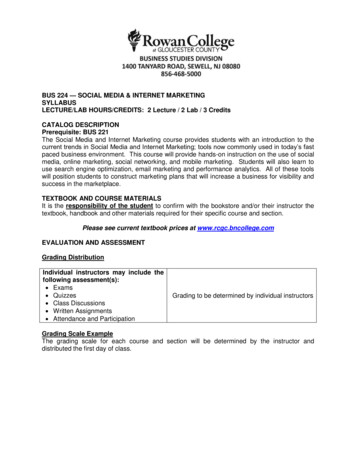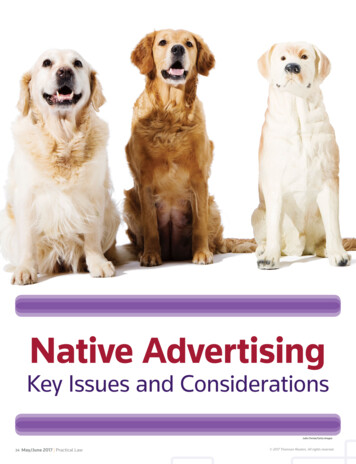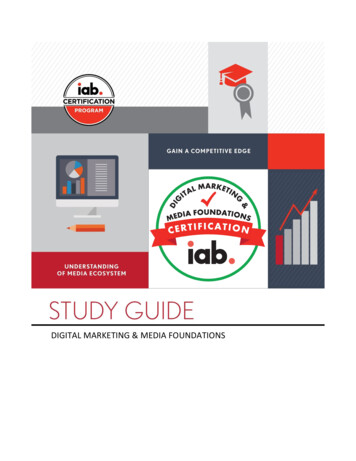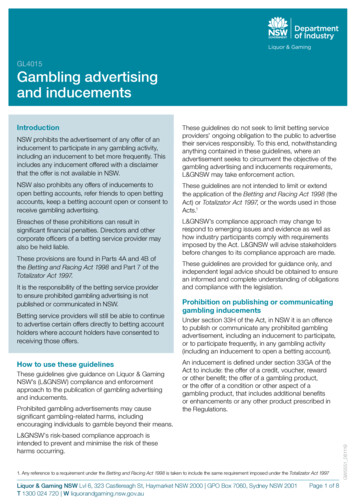
Transcription
Social Media Marketing and AdvertisingYogesh K. Dwivedi1School of Management, Swansea University, UKykdwivedi@gmail.comKawaljeet Kaur KapoorBrunel Business School, Brunel University London, UKkawalkap@gmail.comHsin ChenDepartment of Business systems and management, University of Bedfordshire, UKhsinchen2008@gmail.comAbout AuthorsYogesh K Dwivedi is a Professor of Digital and Social Media and Head of Management andSystems Section in the School of Management at Swansea University, Wales, UK. Heobtained his PhD and MSc in Information Systems from Brunel University, UK. He has coauthored several papers which have appeared in international refereed journals such asCACM, DATA BASE, EJIS, IJPR, ISJ, ISF, JCIS, JIT, JORS, TMR and IMDS. He isAssociate Editor of European Journal of Marketing and European Journal of InformationSystems, Assistant Editor of JEIM and TGPPP, Senior Editor of JECR and member of theeditorial board/review board of several journals. He is a life member of the IFIP WG8.6 and8.5.Dr Kawal Kapoor is a Research Fellow in the Business School at Brunel UniversityLondon. She holds to her credit, a PhD in Business Management and an MBA, both fromSwansea University, Wales, and a bachelor’s degree in Mechanical Engineering. Her PhD1Corresponding Author: Professor Yogesh K. Dwivedi, Head of Management and Systems Section, School ofManagement, Room #1, Haldane Building, Swansea University, Singleton Park, Swansea, SA2 8PP, Wales,UK. Tel: 44 (0) 1792 602340, Fax: 44 (0) 1792 295626, Email: ykdwivedi@gmail.com
research was on the subject of diffusion of innovations. She has first/co-authored manypublications for international refereed journals as ISM, ISF, TMR, and others. She also hasthree years of industry experience from working as a software engineer at Accenture services,India.Dr Hsin Chen is a lecturer of Web analytics in the Department of Business Systems andManagement at University of Bedfordshire, UK. She obtained her PhD in InformationSystems from Brunel University, UK and MSc in Information Systems and Technology fromCity University, UK. She has co-authored several papers which have appeared ininternational referred journals and member of the editorial board/review board of severaljournals. She is also a SAP certified associate.AbstractSocial media has recently gained tremendous fame as a highly impactful channel ofcommunication in these modern times of digitized living. It has been put on a pedestal acrossvaried streams for facilitating participatory interaction amongst businesses, groups, societies,organizations, consumers, communities, forums, and the like. This subject has receivedincreased attention in the literature with many of its practical applications including socialmedia marketing (SMM) being elaborated, analysed, and recorded by many studies. Thisstudy is aimed at collating the existing research on SMM to present a review of seventy onearticles that will bring together the many facets of this rapidly blooming media marketingform. The surfacing limitations in the literature on social media have also been identified andpotential research directions have been offered.Keywords Social media, social media advertising, social media marketing, SMM, literaturereview
1. IntroductionOver recent years, social media has grown to gain recognition as a pronounced andparamount marketing factor guiding the success of a product/service/business (Hawkins andVel, 2013). Durkin (2013) claims that people in the early 1990s had begun forming opinionsthat the internet would become the next futuristic tool of relationship marketing. Whenreferring to social media, three aspects often come to mind, the web 2.0, websites thatfacilitate networking and marketing (Gurney et al., 2004; Vila & Kuster, 2004), and the hugeload of information propagation (Willi et al., 2013). Tabloids on the formation of the phrase‘social media’ suggest names such as Tina Sharkey (Babycentre.com, CEO), Ted AOL),DarrellBerry(Writer/Researcher), and Chris Shipley (Cofounder, Guidewire Group), as claiming to havebeen the first people to have used the aforementioned phrase. Reinhard et al (2012) andWeber (2007) support claims that put Chris Shipley in the limelight for having used thephrase social media for the first time. All these claims travel back to the first usage of this inthe early 1990s.Most people regard social media as a mere platform available for sharing their daily updatesand pictures on social networking sites as Facebook and Twitter (Papasolomou andMelanthiou, 2012). In a more informed light, social media has proved itself to be a low costinformation exchange platform available for one and all, be it consumers, businesses,organizations, governments, or any other entity, to learn, educate, share, build, market,advertise, and improvise on the central idea being circulated. Since recently Social MediaMarketing (SMM) has branched out of social media to become tech strategists’ highlyfavoured platform for marketing purposes over conventional marketing. The electronic wordof mouth forms the basis of this form of marketing. Weinberg (2009) defines SMM as anintegrative process aimed at promoting goods and services over platforms of social media,
which has the potential to target a far wider consumer base in comparison to the traditionalforms of marketing.There is huge body of literature emerging on SMM, which is widely scattered across variouscategories. Being a fairly recent branch of literature, it lacks the deserved synthesis, and thus,this paper is aimed at collating the diverse extant literature on SMM to synthesize and presentsuccinct understandings into the dynamics of social media marketing. The remaining part ofthis paper has been structured as follows – the paper will begin with defining SMM followedby synthesizing the literature available on SMM. The section after, will briefly discuss thesynthesized literature and collate research directions for the future. The last section will bringout the key conclusions and list out the limitations in this body of literature, if any.2. Defining Social Media MarketingThe literature showcases the different emerging definitions for social media marketing(SMM). According to Pentina and Koh (2012), SMM triggers viral communications amongstconsumers across online communities, brand and fan pages, and promotion-related contentgenerated by the companies/organizations on popular networking sites such as Twitter,Facebook, and many others. Jara et al (2014) define SMM as a new generation marketing toolencouraging higher attention and participation from the consumers through the use of socialnetworks. Kim and Ko (2012) describe SMM as an empathy driven communication for youngconsumers with efforts also being targeted at consumers belonging to higher age bands.Richter and Schafermeyer (2011), on the other hand, regard SMM as a marketing strategyengaging with social platforms to facilitate a two way communication with the consumers. Inamalgamating understandings from the available literature (Jara et al., 2014; Kim and Ko,2012; Pentina and Koh, 2012; Richter and Schafermeyer, 2011), SMM can rather be definedas a dialogue often triggered by consumers/audiences, or a business/product/service that
travels in a circle amongst the stated parties to set in motion revealing communications onsome promotional information, or to learn from one another’s use experiences, eventuallybenefitting either or all of the involved parties.3. Synthesizing Literature on Social Media MarketingAs mentioned in section 1, the literature on SMM is vast. To synthesize this literature, it wasessential to gain access to the relevant publications. The search engine, Scopus was used forextracting publications using either social media marketing or social media advertising as thetwo keywords to be present in the title of those publications. The keyword search for therelevant literature on social media marketing fetched seventy one studies, altogether. Thesestudies were grouped under 11 different categories on the basis of the area in which SMMwas being explored. These categories were – healthcare and wellbeing, analytics andsentiment analysis, finances, advertising, education, small and medium enterprises (SMEs),brand fans and followers, banking, general marketing, music industry, and mobile marketing.These 71 retrieved articles will be individually discussed for their key issues across theeleven subsections within this section.3.1 SMM in Healthcare and WellbeingThere were nine studies mainly investing efforts in evaluating the role of SMM in thehealthcare and wellbeing industry. Thackeray et al (2008) in their study suggest that SMMwill allow the health practitioners to establish a direct relationship with their clients, and suchhealth promotion planners need to put their creative best forward to integrate SMM withintheir strategies to make full use of its potentials in marketing their products. Taubenheim et al(2008) run a pilot project to redirect traffic to webpage dedicated to a health awarenesscampaign on heart disease for women. They report that their SMM advertising turned out tobe cost efficient and helped create a viral impact in promoting the heart truth message to
reach out to a wide base of women, ultimately showing a drop in the death rate of womenfrom heart diseases in 2008 (which is the year when SMM employed the heart truth team) incomparison to 2002 (which is the year when the hearth truth team came into being). Clergy(2012) promote the use of SMM by medical practitioners to help them attract new patients.They present SMM as a highly impactful networking tool to make a practice visible in anetwork for encouraging and propagating referrals through known and trusted people toensure effective message communication.Frandsen et al (2013) investigated the viability of employing social media for appointing acommunity sample of smokers for participating in clinical trials. They used both traditionalmedia (flyers, newspapers) and social media (Facebook) to recruit treatment seekingsmokers. The participant-samples were compared for their demographics, smokingcharacteristics, and associated costs; they concluded that both forms of media fared equallywell, with a special mention on social media being more advantageous than the traditionalforms of recruitment. Gupta et al (2013) in reviewing the literature on SMM in healthcaremention that fewer studies explored the role of this media form in healthcare. They recognizesocial media to be a boon when it comes to communicating issues related to public health ingeneral and in times of crisis, and declare it to be the most fitting option for making thegeneral public literate and aware of health related concerns.A 2013 report by Dr. Williams presses on the topic of behavioral marketing, whereby acritical need for preventing social media from directly marketing unhealthy foods toadolescents is expressed. The study instead proposes a rightful and conscious use of socialmedia, whereby measures should be put in place to promote healthier eating habits especiallyamongst the youth (Williams, 2013). Moving onto the wellbeing part, Orsini (2010) looks atSMM in homecare. Whilst many other studies raise the point that one of the problems with
social media is it being mostly used by the youth, Orsini (2010) interestingly claim that seniorcitizens are one of the largest user groups on Facebook. They identify blogs, Facebook,Twitter, and LinkedIn as the four most used SMM platforms. They recommend readers to usethese platforms to access and give out home healthcare related information. Lagrosen andGrunden (2014) investigate the role of SMM across seven spa hotels, and report that thesehotels under utilize SMM as only a business to consumer communication medium, asopposed to a consumer to business interaction tool.Abrahams (2012) research was focused on examining how social media such as Facebookand YouTube are being used to promote the use of infant formula against those promoting theuse of breast milk. They identify 11 formula brands available in the US to be present onsocial media. They identify some code violations that have remained unmonitored in theprocess. Mackey and Liang (2013) explore the darker side of unregulated SMM by postingfake adverts on Facebook, Google , Twitter, and MySpace on illicitly selling no prescriptiondrugs online over a period of 10 months. The results reveals that this direct to consumeradvertising strategy attracted a traffic of over 2500 visitors from all over the world with nosocial media authorities questioning or doubting the presence of such illicit ads and weblinks. Along a parallel plane, Miller (2014) accuse social media websites like Facebook,Twitter, and YouTube to be guilty of miscommunication, or in other words, communicatingand propagating poorly moderated or wrong information on health related issues.3.2 Social Media Analytics and Sentiment AnalysisAccording to Cvijikj and Michahelles (2011), capturing consumer feelings associated with abrand/product is a key element for monitoring social media. Bruner (2011) look into what a‘like’ on a social media site really indicates. They question Facebook’s metric system andaddress its lack of ability to point at the site that redirects traffic to a fan page, eventually
leading to the likes for posts and pictures on that page. Chan and Guillet (2011) usesecondary data from 23 social media sites to investigate the spread of SMM across 67 HongKong hotels. They make suggestions along the lines of the importance of understandingSMM and its roles at different levels, involvement of the hotel staff in managing SMM,opting for the right social media, generating content of interest to the guests on such media,sustainable strategies, and quick access to the hotel’s media page; all of these to be followedthrough for effective SMM.Saravanakumar and SuganthaLakshmi (2012) divide social media and its forms across eightdifferent categories to emphasize its utilization by different types of businesses to promotetheir brands and interact with their customers to achieve maximum exposure and visibility.They rank social media highly as an impactful marketing media. Cambria et al (2012) offeran SMM tool in their study that uses artificial intelligence and semantic techniques to captureand manage user opinions and sentiments over the web. They propose for it to be useful formarketers as well as the users themselves for effectively managing information on brands andproducts available via social media.Li et al (2013) employ an integrated framework for examining the sentiments of Chinesesocial media users. They use the elastic net model and support vector machine to undertaketwo experimental studies. The ability to interpret offered by the elastic net is revealed to bepromising when it comes to sentiment analysis in social media. Podobnik (2013) carry out acase study of premier league brands to analyze the performance indicators of SMM viaFacebook. The study proposes and tests varied hypotheses, and concludes that these sportbrands should invest dedicated efforts in widening their fan base, whilst the managers ofthese brands should protect the brands against any fraudulent activities pursued in the nameof the brand by pretentious fans on social media. Vorvoreanu et al (2013) employ social
media analytics via Twitter, Facebook, and blogs using keyword and hashtag search forassessing the people perceptions of Indianapolis hosting super bowl XLVI. They associatethe credibility of social media for allowing a real-time sentiment monitoring of the public,with social media faring higher than the traditional media for successful marketing.3.3 SMM and Return on InvestmentsHoffman and Fodor (2010) list and talk about the importance of many social metrics acrossbrand awareness and engagements that typically capture the brand-specific behaviours(posts/tweets) on social media; they link the use of such social metrics with the marketersbecoming capable of putting desirable cost-effective strategies sufficient to attract handsomereturns on their investments. Lugmayr (2012) discuss the general role of social media inadvertising and promotion, narrowing it down to its application as a financial product,particularly for share trading in the stock exchange market. They place special emphasis onthe timely distribution of information being the remarkable quality of social media incomparison to the other traditional forms. In an alternate type of study, Kumar andMirchandani (2012) propose a seven steps method for SMM to increase the returns oninvestment. They developed metrics such as customer influence effect and customerinfluence value to assist effective SMM that can reveal important information at organizationand consumer levels. Kumar and Sundaram (2012) evaluate and recommend regulated SMMwhere an encouraging environment is created, where users feel motivated to shareinformation on businesses within their social networks. They suggest for this type of SMM tobe fitting where flexible marketing and higher returns on investments are desired. Similarly,Kumar et al. (2013) demonstrated use of social media for generating growth in sales, returnon investments, and positive word of mouth.
3.4 Social Media AdvertisingHensel and Deis (2010) bring to the fore the pluses and minuses of using social media. Theysuggest for businesses and entrepreneurs to be fully informed by being up to date with theirpresence over social media. They also suggest for businesses to be constantly monitoring thesame to learn from consumer feedback, and at the same time to ensure that no third party isattempting to bring them defamation. Ramsay (2012), on the other hand, picks on theetiquettes to be followed on social media. They suggest the general dos and don’ts for theactive users of social media and lay out custom specific etiquettes for Facebook, Twitter,YouTube, and LinkedIn users. Carmichael and Cleave (2012) advertised on Facebook andmonitored two advertisements to capture the user-advert interaction and its effectiveness forsmall businesses. For the amount a small business would invest in such social mediaadvertising, they found that this form of advertising could substantially improve the visibilityof such businesses and easily redirect consumer traffic to the advertised business page.Gu and Wang (2012) study the data from 100 enterprises to identify the problems that arisefrom the use of microblogging for marketing. They use comment and forwarding statistics fortheir analysis, which they also recognize are the two significant indicators utilized byenterprises to measure the SMM outputs. They elaborate on the apparent flaw, whereby theenterprises register in haste, but fail to attract substantial attention from their target users;they conclude that SMM can produce potential results, provided there is sufficient customerinteraction, feedback, and efficient moderation of the content posted on social media. Powerset al (2012) present an excerpt from an extensive research on the role of social media inconsumer purchase behaviour. Involving some big names as General Motors, Google, andothers, a qualitative and quantitative research in combination was pursued by them. Theresults show that consumer empowerment has achieved a new high with social media, and
has opened platforms for brands and their consumers to openly communicate and connect,adding value for both parties, overall.Minton et al (2012) engage in gathering data from US, Germany, and South Korea onmotives behind using Facebook and Twitter in the sustainable marketing context usingphilosophies of psychology. The study concludes for South Korea to lead with the socialmedia initiatives involving sustainable behaviours, with Germany taking a lead specificallyon recycling initiatives. Khang et al (2012) review the literature available on social media andfind out that most SMM related studies are mostly directed at the users and uses of socialmedia, and that the numbers of such studies have only increased since the introduction ofFacebook and Twitter in 2004 and 2006, respectively. Okazaki and Taylor (2013) study theexisting literature on social media in international advertising and identify network capability,image transferability, and personal extensibility to be the three important theoreticalparadigms offering substantial insights into the pluses and minuses of social mediaadvertising.3.5 SMM in EducationIn the education field, Richter and Schafermeyer (2011) examine the SMM of an organizationran by students, whilst placing specific attention in the related activities on Facebook andTwitter. They conclude that SMM complements traditional marketing strategies in conveyingtimely information, and maintaining interaction and transparency. Reinhard et al (2012) showstudent involvement in developing a marketing strategy to transform a non-profit communityinto a profit yielding healthcare company assisting people seeking to quit smoking. Theyshow how devising an SMM strategy was an enriching learning experience for the students,and justify its inclusion in the curriculum, and mark it highly for its practical experience incomparison to the traditional educational methods.
In another type of study (Palmer, 2012), SMM via Facebook is used to advertise an academicprogram. Contrary to its expectations, Facebook advertising did not fetch any studentapplications for the advertised program. The study concludes that it is not sufficient to justadvertise on a social networking site; to reap the benefits of SMM, it is important to dedicatetime for monitoring user responses, and interacting with the individual users. Zehrer andGrabmuller (2012) investigates an Austrian educational institution’s SMM strategy in usingsocial networking sites to actively engage with students interested in tourism education.Facebook emerged a winner with it being most used by students. They emphasize on theimportance of effective management of a social networking page and mostly present thepluses and minuses of such SMM in higher education. Luo et al (2013) examine perception ofstudents on a China-based academic library’s online video marketing campaign. Their studyreveals that the posted content, the humour induced within that content, use of social media,and partnering engagements with the students were the success factors of the campaign beinginvestigated.3.6 SMM and SMEsA UK based study by Michaelidou et al (2011) investigates the barriers and benefits of usingSMM by the SMEs. Whilst they insist on confirming the relevance of business with the socialnetworking site that is being chosen for implementing the SMM strategies, they identify theprior mindsets and lack of familiarity and training to be the obvious barriers to the acceptanceof SMM by SMEs. They however do mention the rising awareness of the SMM benefits,such as customer interaction and stronger identity creation, amongst the same SMEs. Pentinaand Koh (2012) invest efforts in developing a typology of SMM strategies generallyemployed by the SMEs, which are basically governed by the nature and objectives of thoseSMEs. They recommend employing a strategic mix of SMM and other communication forms
to achieve best results. A Macedonian study by Fetaji and Demiri (2012) empirically evaluatethe acceptance of SMM by SMEs and show that perceived usefulness significantly influencesthe intention to use social media. The surfacing revelation is that most SMEs in Macedoniaare inclined towards the traditional approaches and see SMM as a threat, a view that is soonexpected to diminish for SMM to eventually emerge as a winner.3.7 SMM and Brand Fans and FollowersKim and Ko (2011) empirically examine the influence of SMM on 362 luxury fashion brandusers’ intentions. Their findings show that SMM have a dramatic positive influence where thebrand-consumer interaction enhances the unique brand value, which the traditional marketingoften fails to offer. Cvijikj and Michahelles (2011) monitored a Facebook brand page for overa year to analyse the consumer comments. For the authors suggest marketers have anunderstanding of the content that people share and their motivation behind it. They identifyrequests and suggestions from the people to be the common intention behind the peopleparticipation for the analysed brand page. de Vries et al (2012) consider 11 internationalbrands and the impact they make on their customers through their presence on socialnetworking sites. They find that creating a brand page does increase brand popularity, andinsist on the importance of lending an ear to what the brand users have to say to address andinteract with them efficiently to reap the full benefits of using SMM.Lipsman et al (2012) place special interest in Facebook and similar social media as commonplatforms shared by brands and their consumers. They propose the use of a measurementapproach that offers a deeper insight into the types of audience to enable marketers betteralign their strategies via SMM. An article on long term effects of SMM by Mccluskey (2012)has one of the field experts strongly suggesting that it is not just to increase the number offans/followers that the brand pages on SMM should be aiming at, instead they should be
focusing on engaging with those fans in an active manner in different ways to earn theirloyalty and to establish a strong customer-brand connection, overall. They stronglyrecommend using a social media site/platform that closely resonates with the product/servicebeing marketed.Petty (2012) discusses some social media attacks that some brands have encountered. Theysuggest for brands to be mindful of – monitoring the social media content of relevance tothem, imposters, and carefully regulating any negative threads running across the socialmedia. They mostly press on judicious use of the available legal tools to combat thenegativities related to them circulating over the social media sites. Shen and Bissell (2013)investigate the use of Facebook by top beauty brands to make an impact by establishingcommunications with their customers using social media. They study different beauty brandsby analysing the Facebook pages and the content posted on those pages by these brands. Thestudy concluded that engaging in the electronic word of mouth as an important part of thebranding strategies to enhance brand image has become a ruling strategy with most of thebeauty brands.3.8 SMM and BankingRamirez (2010) offer tips for integrating social media in recruiting bank employees alongsidecost savings. The author begins with stressing on the importance of clarity of strategy, andthen lists and details the available social networking sites (LinkedIn, Twitter, Facebook,YouTube, and Google) for attracting prospective quality candidates. Mitic and Kapoulas(2012) carry out three case studies to explore relationship marketing in retail banking inSouth East Europe. Their study revealed that owing to security issues and poorly alignedrelationship management strategies, customers did not prefer social media to interact withbanks with their choices. Chikandiwa et al (2013) examine the SMM models used by South
African banks to create an online presence. While at one end the use of SMM is encouraged,there at the other, some legal factors surface up as the barriers to its acceptance. Althoughslowly diffusing, presently these banks are pursuing SMM mostly via Facebook and Twitter.3.9 Social Media and MarketingKaun (2010) writes an article for the early SMM enthusiasts giving them a heads up on howonly creating a profile on social media sites would be unfruitful unless the employed SMM ismanoeuvred in the right direction. They emphasize the importance of interactivity andcommunity building, whilst offering basic sustainable tips for achieving successful SMM.Tenaiji and Cader (2010) explore the extent of SMM usage in the UAE organizations andreport that it is still picking up pace in the country and has gained recognition only recently.They list awareness, advertising, and feedback as the top three motives of organizationsbehind the use of SMM. Facebook, Twitter, YouTube, and Flickr were identified at the mostused sites for SMM purposes. They pick on the flaw of SMM underutilization, whereby theorganizations focussed more on communicating to, rather than interacting with the users onsocial media.Akar and Topcu (2011) empirically analyse data gathered from an academic university wherethey developed a consumer based scale to test hypotheses, and found that majorityrespondents used sites as YouTube and Facebook; their usage of these sites defined theirattitude towards SMM. They highlighted that users on social media do not have a positiveperception of SMM activities, and the marketers should more actively concentrate onproducing relevant content on such sites rather than depending on user activity to propagatethe needful. Ralphs (2011) talks about social currency, which in their article, has beenrecognized as the value a business/individual can yield out of being entertaining. They lay allemphasis on spotting and building one’s social currency for achieving successful SMM.
Kaplan and Haenlein (2011) discuss the concept of viral marketing and evaluate theimportance of message content, messengers, and environment. They identify and discuss fourcategories of such viral marketing campaigns and offer suggestions from the managerialperspectives for achieving such successful campaigns. Chen et al (2011) study how theconsumer-posted reviews over the social media tend to change with different stages ofproduct maturity. They consider marketing variables and empirically analyse automobiledata from 2001 and 2008 to observe evolution of consumer reviews over time.Ketter and Avraham (2012) discuss place marketing to explore the distinct roles au
Systems, Assistant Editor of JEIM and TGPPP, Senior Editor of JECR and member of the editorial board/review board of several journals. He is a life member of the IFIP WG8.6 and 8.5. Dr Kawal Kapoor is a Research Fellow in the Business School at Brunel University London.
